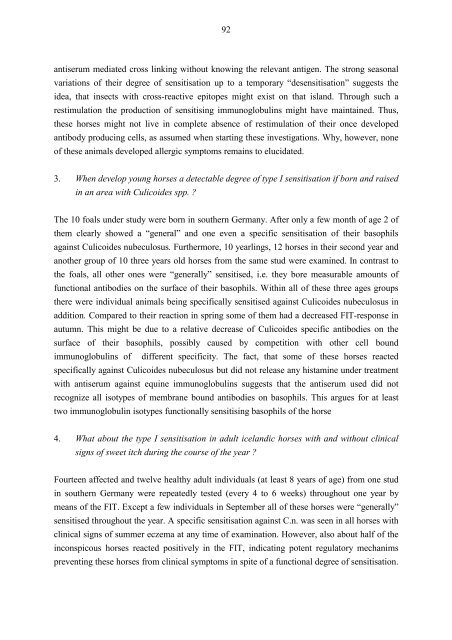Aus der Arbeitsgruppe Immunologie der Tierärztlichen Hochschule ...
Aus der Arbeitsgruppe Immunologie der Tierärztlichen Hochschule ...
Aus der Arbeitsgruppe Immunologie der Tierärztlichen Hochschule ...
Sie wollen auch ein ePaper? Erhöhen Sie die Reichweite Ihrer Titel.
YUMPU macht aus Druck-PDFs automatisch weboptimierte ePaper, die Google liebt.
92<br />
antiserum mediated cross linking without knowing the relevant antigen. The strong seasonal<br />
variations of their degree of sensitisation up to a temporary “desensitisation” suggests the<br />
idea, that insects with cross-reactive epitopes might exist on that island. Through such a<br />
restimulation the production of sensitising immunoglobulins might have maintained. Thus,<br />
these horses might not live in complete absence of restimulation of their once developed<br />
antibody producing cells, as assumed when starting these investigations. Why, however, none<br />
of these animals developed allergic symptoms remains to elucidated.<br />
3. When develop young horses a detectable degree of type I sensitisation if born and raised<br />
in an area with Culicoides spp. ?<br />
The 10 foals un<strong>der</strong> study were born in southern Germany. After only a few month of age 2 of<br />
them clearly showed a “general” and one even a specific sensitisation of their basophils<br />
against Culicoides nubeculosus. Furthermore, 10 yearlings, 12 horses in their second year and<br />
another group of 10 three years old horses from the same stud were examined. In contrast to<br />
the foals, all other ones were “generally” sensitised, i.e. they bore measurable amounts of<br />
functional antibodies on the surface of their basophils. Within all of these three ages groups<br />
there were individual animals being specifically sensitised against Culicoides nubeculosus in<br />
addition. Compared to their reaction in spring some of them had a decreased FIT-response in<br />
autumn. This might be due to a relative decrease of Culicoides specific antibodies on the<br />
surface of their basophils, possibly caused by competition with other cell bound<br />
immunoglobulins of different specificity. The fact, that some of these horses reacted<br />
specifically against Culicoides nubeculosus but did not release any histamine un<strong>der</strong> treatment<br />
with antiserum against equine immunoglobulins suggests that the antiserum used did not<br />
recognize all isotypes of membrane bound antibodies on basophils. This argues for at least<br />
two immunoglobulin isotypes functionally sensitising basophils of the horse<br />
4. What about the type I sensitisation in adult icelandic horses with and without clinical<br />
signs of sweet itch during the course of the year ?<br />
Fourteen affected and twelve healthy adult individuals (at least 8 years of age) from one stud<br />
in southern Germany were repeatedly tested (every 4 to 6 weeks) throughout one year by<br />
means of the FIT. Except a few individuals in September all of these horses were “generally”<br />
sensitised throughout the year. A specific sensitisation against C.n. was seen in all horses with<br />
clinical signs of summer eczema at any time of examination. However, also about half of the<br />
inconspicous horses reacted positively in the FIT, indicating potent regulatory mechanims<br />
preventing these horses from clinical symptoms in spite of a functional degree of sensitisation.










![Tmnsudation.] - TiHo Bibliothek elib](https://img.yumpu.com/23369022/1/174x260/tmnsudation-tiho-bibliothek-elib.jpg?quality=85)






